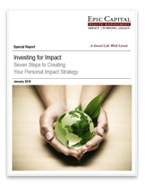Preparing for the Fed Pivot
Dec 15, 2023
 Key Takeaways:
Key Takeaways:
- Since inflation is going in the right direction and the labor market is getting more into balance, the Federal Reserve (Fed) is likely done raising rates. We should expect the committee to prepare investors for a slight pivot in policy.
- The markets expect the Fed’s next action will likely be a cut in rates by mid next year but much of that is predicated on the economy weakening enough to warrant a cut.
- Both equity and bond markets have latched onto the notion that the Fed is done raising rates which has been a catalyst for the recent rally.
- The updated Summary of Economic Projections (SEP) will likely push back on the market’s expectations that the Fed will cut rates by over a full percentage point. But the
SEP is a poor predictor of future rates.
Favorable Inflation Trajectory
The November annual rate of inflation dipped to 3.1% from 3.2% last month as energy prices continued to plummet. Despite the month-over-month rise in November prices, the Fed is still expected to hold rates unchanged at the final meeting of 2023. Rising shelter costs, medical care, and car insurance prices were the main drivers in November’s Consumer Price Index (CPI), but the decline in apparel was revealing. Apparel declined by 1.3%, the largest monthly decrease since the onset of the pandemic and could illustrate the growing price-consciousness of the consumer.
The decline in aggregate goods prices could be in response to the bargain hunting at the start of the holiday sales season.
Further, the soft reading from the latest Producer Price Index (PPI) shows the pipeline of inflation is loosening, giving the Fed some leeway with future policy. For now, investors will have to come to grips with the diverging glide paths between goods prices and services prices. As shown in the chart, the annual growth rates between services and goods are getting closer into balance but services disinflation has more room to run.
Too Early to Declare Victory
The Fed will by no means declare victory since the annual core inflation rate (excluding food and energy) in November was 4.0%, double the long-run target rate set by the Fed. However, the trajectory is encouraging.
As noted in the chart above, the annual rate of headline inflation is 3.1% and will likely decline further from here. Despite inflation running above the Fed’s target, the Fed will likely hold rates steady at the next few meetings as policy makers—and investors too, for that matter—remain concerned about the lagged effects of monetary policy. Given the speed of the past rate hikes, many argue the economy and markets have not yet felt the full impact of the policy tightening.
From an investment standpoint, markets will need to digest the updated Summary of Economic Projections (SEP) which will likely show expectations the Fed will not cut rates as aggressively as markets are anticipating in 2024.
Overall, the Strategic and Tactical Asset Allocation Committee (STAAC) recommends a neutral tactical allocation to equities, with a modest overweight to fixed income funded from cash. The risk-reward trade-off between stocks and bonds looks relatively balanced to us, with core bonds providing a yield advantage over cash. With the Fed likely done hiking rates and yields at attractive levels, bond returns have become increasingly competitive with equities.
IMPORTANT DISCLOSURES This material is for general information only and is not intended to provide specific advice or recommendations for any individual. There is no assurance that the views or strategies discussed are suitable for all investors. To determine which investment(s) may be appropriate for you, please consult your financial professional prior to investing. Investing involves risks including possible loss of principal. No investment strategy or risk management technique can guarantee return or eliminate risk in all market environments. For more information on the risks associated with the strategies and product types discussed please visit https://lplresearch.com/Risks References to markets, asset classes, and sectors are generally regarding the corresponding market index. Indexes are unmanaged statistical composites and cannot be invested into directly. Index performance is not indicative of the performance of any investment and do not reflect fees, expenses, or sales charges. All performance referenced is historical and is no guarantee of future results. Unless otherwise stated LPL Financial and the third-party persons and firms mentioned are not affiliates of each other and make no representation with respect to each other. Any company names noted herein are for educational purposes only and not an indication of trading intent or a solicitation of their products or services. All information is believed to be from reliable sources; however, LPL Financial makes no representation as to its completeness or accuracy. For a list of descriptions of the indexes and economic terms referenced in this publication, please visit our website at lplresearch.com/definitions. Securities and advisory services offered through LPL Financial, a registered investment advisor and broker-dealer. Member FINRA/SIPC.
More Insights
Medicare won’t cover all of your health-care costs during retirement, so you may want to buy a supplemental medical insurance policy known as Medigap. Offered by private insurance companies, Medigap policies are designed to cover costs not paid by Original Medicare (Parts A and B), helping you fill the gaps in your Medicare coverage. You’ll … Continue reading “Buying Supplemental Health Insurance: Medigap”
Incapacity can strike anyone at any time. Estate Planning plans for it By definition, estate planning is a process designed to help you manage and preserve your assets while you are alive, and to conserve and control their distribution after your death according to your goals and objectives. But what estate planning means to you … Continue reading “Estate Planning Intro”
You’re beginning to accumulate substantial wealth, but you worry about protecting it from future potential creditors. Whether your concern is for your personal assets or your business, various tools exist to keep your property safe from tax collectors, accident victims, health-care providers, credit card issuers, business creditors, and creditors of others. To insulate your property … Continue reading “Estate Planning – Protecting Your Assets”
It seems like we just can’t stop talking about the Federal Reserve (Fed). After an aggressive rate hiking campaign that we think ended last year, markets were expecting the Fed to start cutting interest rates as early as next month. But withan economy that continues to surprise to the upside, along with inflationary pressures that … Continue reading “Market Update – The Patient Pause”
A thoughtful retirement strategy may help you pursue your many retirement goals. That strategy must consider many factors, and here are just a few: your income needs, the order of your withdrawals from taxable and tax-advantaged retirement accounts, the income tax implications of those withdrawals, and sequence of return risk.
Services
Epic Capital provides the following comprehensive financial planning and investment management services: Learn More >




 Top of Page
Top of Page











